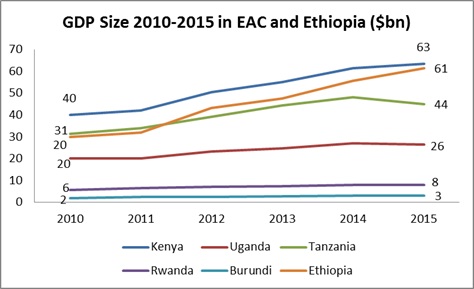News
U.S. Chamber releases new report on trade facilitation in East Africa, outlines transformational projects and opportunities for U.S. investment

The U.S. Chamber of Commerce U.S.-Africa Business Center released a new on 18 October 2016 on trade facilitation in East Africa, outlining the work governments in the region have undertaken to improve infrastructure and address economic challenges, and offering recommendations to address and overcome remaining trade barriers.
In the past decade, East Africa’s growth has outpaced the rest of the continent. Regional integration has aided in boosting trade within the region and improved East Africa’s access to global markets. Though some barriers to trade remain, several large-scale infrastructure projects currently underway hold promise for improved trade relationships and economic productivity for East Africa.
“East Africa is a vibrant, fast-growing region of the world with a great deal of untapped potential,” said Scott Eisner, president of the U.S.-Africa Business Center and vice president of African Affairs for the U.S. Chamber. “Though the relationships between the U.S. and East African nations have deepened in recent years, trade between us remains limited. As the region undertakes and completes a set of high-priority infrastructure projects, opportunities will ripen for strategic engagement on the part of the U.S. private sector in a brighter future for East African trade.”
The U.S. Chamber of Commerce and the Africa Expert Network have highlighted the economic diversity of East Africa’s six critical economies and examined the EAC’s role in implementing rapid institutional change and becoming one of the continent’s most dynamic trade blocks. The EAC has gradually reduced tariffs, trade barriers, and bottlenecks in the region, helping members increase their trade performance, all key factors which promote East Africa as a great region for trade opportunities.

U.S. Chamber of Commerce and the Africa Expert Network
While U.S. trade with this region is still limited, representing just 5 percent of total East African trade, China and India have become the region’s largest trading partners and the European Union is looking to develop a stronger partnership as well.
The United States’ share of East African trade in 2015

U.S. Chamber of Commerce and the Africa Expert Network
Governments are actively working to reduce trade barriers and address infrastructure challenges, as well as shifting their policies to attract foreign investment. The Trade Facilitation Agreement (TFA), a landmark agreement concluded by the World Trade Organization in 2013, is also aimed at solving these issues, but has yet to be ratified as of June 24, 2016.
But even as those broader market access and policy changes continue to take hold, East African countries are currently moving forward with transnational and national infrastructure projects that have the potential to change the face of international trade in the region.
In the coming years, East African economies will likely follow in the footsteps of the “Next Eleven,” a group of 11 countries that were identified by Goldman Sachs as the successors of the BRIC countries. The only question is what direction the U.S. will take in its trade relationship with East Africa, especially as other nations continue to increase their investment in the region.
The report highlights a number of large-scale infrastructure projects with the potential to improve trade in the East African region and offers several recommendations for reducing impediments to trade through additional transformative trade infrastructure projects.
Implementation of these recommendations in East Africa, the report says, will create more opportunities for U.S. companies in new and existing infrastructure initiatives, as well as in other industries like tourism, agriculture, manufacturing, and energy.
The U.S. Chamber of Commerce is the world’s largest business federation representing the interests of more than 3 million businesses of all sizes, sectors, and regions, as well as state and local chambers and industry associations. Its International Affairs division includes more than 70 regional and policy experts and 25 country- and region-specific business councils and initiatives. The U.S. Chamber also works closely with 117 American Chambers of Commerce abroad.




